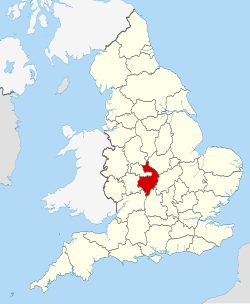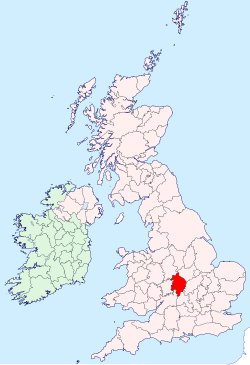Warwickshire | |
|---|---|
Kenilworth Castle; statue of George Eliot, Nuneaton; and Royal Shakespeare Theatre, Stratford-upon-Avon | |
| Sovereign state | United Kingdom |
| Constituent country | England |
| Region | West Midlands |
| Established | Historic |
| Time zone | UTC+0 (GMT) |
| • Summer (DST) | UTC+1 (BST) |
| UK Parliament | 6 MPs |
| Largest town | Nuneaton (ceremonial) Birmingham (historic) |
| Ceremonial county | |
| Lord Lieutenant | Timothy Cox |
| High Sheriff | Sophie Elizabeth Hilleary[1] (2023–24) |
| Area | 1,975 km2 (763 sq mi) |
| • Rank | 31st of 48 |
| Population (2022)[2] | 607,604 |
| • Rank | 39th of 48 |
| Density | 308/km2 (800/sq mi) |
| Ethnicity | 92.8% White 4.6% Asian 1.5% Mixed 0.8% Black 0.4% Other[3] |
| Non-metropolitan county | |
| County council | Warwickshire County Council |
| Control | Conservative |
| Admin HQ | Warwick |
| Area | 1,975 km2 (763 sq mi) |
| • Rank | 17th of 21 |
| Population (2022)[4] | 607,604 |
| • Rank | 20th of 21 |
| Density | 308/km2 (800/sq mi) |
| ISO 3166-2 | GB-WAR |
| GSS code | E10000031 |
| ITL | TLG13 |
| Website | warwickshire |
| Districts | |
 Districts of Warwickshire | |
| Districts | |
Warwickshire (/ˈwɒrɪkʃər, -ʃɪər/ ; abbreviated Warks) is a ceremonial county in the West Midlands of England. It is bordered by Staffordshire and Leicestershire to the north, Northamptonshire to the east, Oxfordshire and Gloucestershire to the south, and Worcestershire and the West Midlands county to the west. The largest settlement is Nuneaton and the county town is Warwick.
The county is largely rural; it has an area of 763 sq mi (1,980 km2) and a population of 571,010. After Nuneaton (88,813), the largest settlements are Rugby (78,125), Leamington Spa (50,923), Warwick (37,267), Bedworth (31,090) and Stratford-upon-Avon (30,495). For local government purposes, Warwickshire is a non-metropolitan county with five districts. The county historically included the city of Coventry and the area to its west, including Sutton Coldfield, Solihull and a significant part of Birmingham, including the city centre.
Warwickshire is a flat, lowland county, but its far south contains part of the Cotswolds AONB. The River Avon, a major tributary of the Severn, flows through the south of the county.
The region was part of Roman Britain and later the Roman road called Watling Street became the boundary between the Anglo-Saxon kingdom of Mercia and the Danelaw. The county was relatively settled during the rest of the Middle Ages and Early Modern period; Coventry developed as a major centre of the textiles trade. The playwright William Shakespeare was born in Stratford-upon-Avon in 1564, living much of his life there, and the Gunpowder Plot of 1605 was planned near Snitterfield. During the Industrial Revolution, the Warwickshire coalfield was exploited and Coventry and the west of the county became manufacturing centres; Leamington Spa developed as a tourist resort at the same time. The Victorian novelist Mary Ann Evans, better known as George Eliot, was born just outside Nuneaton in 1819.
- ^ "Warwickshire 2023/2024". High Sheriffs' Association of England and Wales. Retrieved 17 February 2024.
- ^ "Mid-2022 population estimates by Lieutenancy areas (as at 1997) for England and Wales". Office for National Statistics. 24 June 2024. Retrieved 26 June 2024.
- ^ "2011 Census: Key Statistics for local authorities in England and Wales" (XLS). Ons.gov.uk. Archived from the original on 24 February 2016. Retrieved 19 July 2017.
- ^ "Mid-Year Population Estimates, UK, June 2022". Office for National Statistics. 26 March 2024. Retrieved 3 May 2024.




